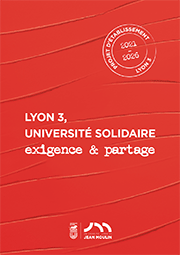AccueilRechercheProgrammes et productions scientifiquesThèsesThèses soutenuesThèses soutenues - 2006-2021Thèses soutenues - 2018
-
Partager cette page
- Recherche,
PACCAUD Fran?oise
Le contentieux de l’environnement devant la Cour internationale de Justice
Publié le 28 janvier 2019 – Mis à jour le 29 janvier 2019
Thèse en droit mention droit international et relations internationales, soutenue le 17 septembre 2018.
La CIJ en tant qu’organe judiciaire principal des Nations Unies est amenée à conna?tre de ce type de différend spécifique. En effet, les litiges environnementaux emportent avec eux un certain degré de technicité et font appel à des notions scientifiques particulièrement complexes. La rencontre entre la protection de l’environnement et la CIJ ne pouvait alors que donner lieu à un contentieux particulièrement riche. L’appréhension de ce contentieux par la Cour conduit à s’interroger sur la manière dont cette dernière réceptionne ces litiges. La présente thèse s’intéresse donc aux effets et conséquences résultant du contentieux de l’environnement devant la CIJ. Deux remarques peuvent être formulées : la première concerne le constat d’une intégration progressive des enjeux environnementaux au sein du contentieux international de la CIJ, et la deuxième concerne l’opportunité pour la Cour d’adapter ses règles procédurales. Une adaptation des règles procédurales de la CIJ serait souhaitable. En effet, les enjeux environnementaux tendent à s’intégrer de plus en plus au sein du contentieux international de la CIJ qui contribue de ce fait au développement des règles de droit international de l’environnement. Toutefois, une telle intégration révèle également les limites de la Cour. La Cour pourrait endosser le r?le de juge environnemental, en prenant en considération les spécificités de ce contentieux, notamment par l’adaptation de ses outils procéduraux. Ainsi, c’est une dynamique réciproque qui s’installe entre la Cour et la protection de l’environnement. La préservation de l’environnement est enrichie par la Cour, mais cette dernière pourrait également voir son r?le évoluer gr?ce à la prise en considération des enjeux environnementaux. La CIJ pourrait alors devenir un véritable juge international de l’environnement dont la communauté internationale manque encore.
The ICJ as the principal judicial organ of the United Nations comes to know of this type of specific dispute. In fact, environmental disputes carry with them a certain degree of technicality and call upon particularly complex scientific notions. The meeting between the protection of the environment and the ICJ could then only give rise to a particularly rich litigation. The Court's apprehension of this kind of litigation raises the question of how the Court deals with these disputes. The present thesis is therefore concerned with the effects and consequences resulting from the environmental litigation before the ICJ.
This leads us to two remarks: the first one concerns the phenomenon by which environmental stakes are integrated within international litigation, and, the second one concerns the opportunity for the court to adapt its procedural rules to deal with environmental issues. Indeed, environmental issues tend to be more and more integrated into the international litigation of the ICJ, which contributes to the development of the rules of international environmental law. However, such integration also reveals the limits of the Court. However, the Court could take on the role of an environmental judge, by adapting its procedural tools to the specificities of this particular litigation. Thus, it is a reciprocal dynamic that takes place between the Court and the protection of the environment. The preservation of the environment is enriched by the Court, but the Court could also see its role evolve through the consideration of environmental issues. The ICJ could then become a genuine international environmental judge whose international community is still lacking.
The ICJ as the principal judicial organ of the United Nations comes to know of this type of specific dispute. In fact, environmental disputes carry with them a certain degree of technicality and call upon particularly complex scientific notions. The meeting between the protection of the environment and the ICJ could then only give rise to a particularly rich litigation. The Court's apprehension of this kind of litigation raises the question of how the Court deals with these disputes. The present thesis is therefore concerned with the effects and consequences resulting from the environmental litigation before the ICJ.
This leads us to two remarks: the first one concerns the phenomenon by which environmental stakes are integrated within international litigation, and, the second one concerns the opportunity for the court to adapt its procedural rules to deal with environmental issues. Indeed, environmental issues tend to be more and more integrated into the international litigation of the ICJ, which contributes to the development of the rules of international environmental law. However, such integration also reveals the limits of the Court. However, the Court could take on the role of an environmental judge, by adapting its procedural tools to the specificities of this particular litigation. Thus, it is a reciprocal dynamic that takes place between the Court and the protection of the environment. The preservation of the environment is enriched by the Court, but the Court could also see its role evolve through the consideration of environmental issues. The ICJ could then become a genuine international environmental judge whose international community is still lacking.
Mots-clés : Cour internationale de Justice, protection de l’environnement, règles substantielles, outils procéduraux.
Keywords : International Court of Justice, environmental protection, substantial rules, procedural rules.
Co-Directrice de thèse : Laurence BOISSON DE CHAZOURNES
Co-Directeur de thèse : Stéphane DOUMB?-BILL?
Membres du jury :
Mme Laurence BOISSON DE CHAZOURNES, Co-directrice de thèse, Professeure Ordinaire, Université de Genève (Suisse),
M. Stéphane DOUMB?-BILL?, Co-directeur de thèse, Professeur des universités, Université Jean Moulin Lyon 3,
Mme Sandrine MALJEAN-DUBOIS, Directrice de recherche CNRS, Université Aix-Marseille,
M. Jean-Christophe MARTIN, Professeur agrégé, à l’Université de Nice Sophia Antipolis,
M. Tullio SCOVAZZI, Professore Ordinario, Università di Milano-Bicocca (Italie),
Mme Emmanuelle TOURME-JOUANNET, Professeure des universités, IEP Paris.
Président du jury : Jean -Christophe MARTIN
Keywords : International Court of Justice, environmental protection, substantial rules, procedural rules.
Co-Directrice de thèse : Laurence BOISSON DE CHAZOURNES
Co-Directeur de thèse : Stéphane DOUMB?-BILL?
Membres du jury :
Mme Laurence BOISSON DE CHAZOURNES, Co-directrice de thèse, Professeure Ordinaire, Université de Genève (Suisse),
M. Stéphane DOUMB?-BILL?, Co-directeur de thèse, Professeur des universités, Université Jean Moulin Lyon 3,
Mme Sandrine MALJEAN-DUBOIS, Directrice de recherche CNRS, Université Aix-Marseille,
M. Jean-Christophe MARTIN, Professeur agrégé, à l’Université de Nice Sophia Antipolis,
M. Tullio SCOVAZZI, Professore Ordinario, Università di Milano-Bicocca (Italie),
Mme Emmanuelle TOURME-JOUANNET, Professeure des universités, IEP Paris.
Président du jury : Jean -Christophe MARTIN
Documentation
Mise à jour : 29 janvier 2019







